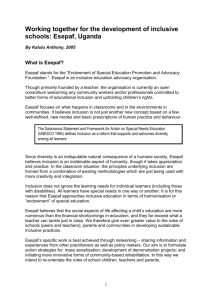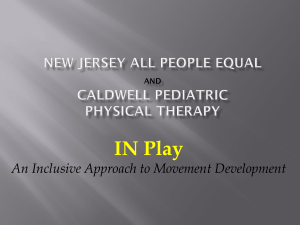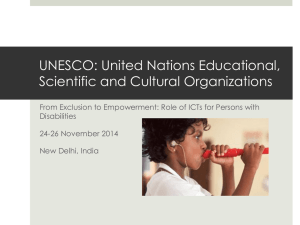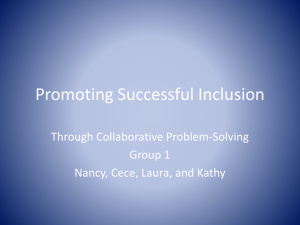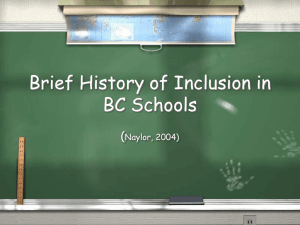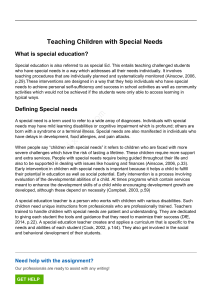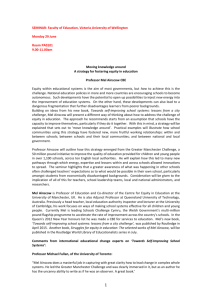Index for Inclusion: developing learning and participation in schools
advertisement
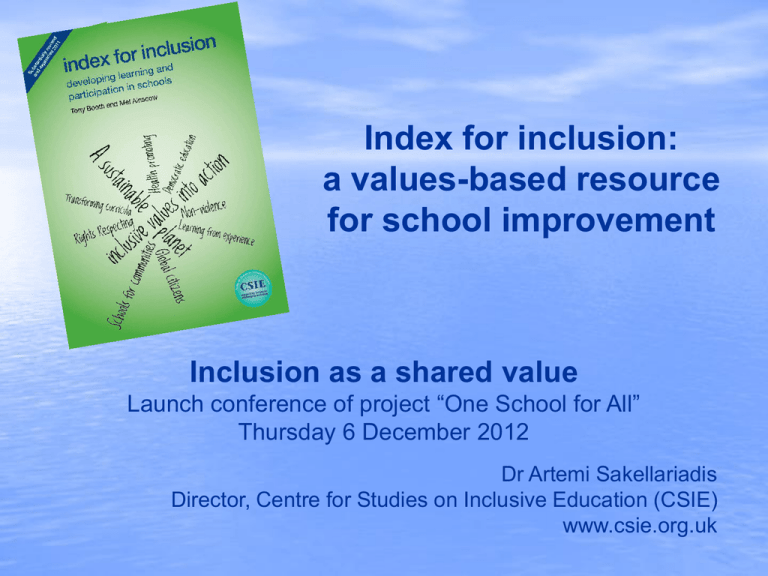
Index for inclusion: a values-based resource for school improvement Inclusion as a shared value Launch conference of project “One School for All” Thursday 6 December 2012 Dr Artemi Sakellariadis Director, Centre for Studies on Inclusive Education (CSIE) www.csie.org.uk Welcome! “Едно училище за всички”, BG051РО001-7.0.01-0069 Проектът се осъществява с финансовата подкрепа на Оперативна програма „Развитие на човешките ресурси”, съфинансирана от Европейския социален фонд на Европейския съюз Index for Inclusion: developing learning and participation in schools (Booth & Ainscow 2011) Introduction What are schools for? Who benefits most from today’s schools? How do schools change? Becoming agents of change... Index for Inclusion: developing learning and participation in schools (Booth & Ainscow 2011) A values-based resource for school improvement Removing barriers to learning and participation. Mobilising resources for support Encouraging a participatory approach Welcoming diversity as a rich resource for learning Index for Inclusion: developing learning and participation in schools (Booth & Ainscow 2011) Some back stories • Idea born in 1993 • “Index team” • 22 schools, 3 years, 2 draft versions • First published in 2000 (28,000+ copies) • 2nd edition 2002 • Early years version 2004, 2006 • 40 translations • 3rd edition 2011 Index for Inclusion: developing learning and participation in schools (Booth & Ainscow 2011) Third edition, substantially revised and expanded • • • • • • User-friendly, includes CD New section on values Proposes new curriculum Builds alliances Revised indicators and questions Flexible use next Comparing curriculum headings back back The three dimensions of the Index The 3 dimensions of the Index • Creating inclusive cultures • Building community • Establishing inclusive values • Producing inclusive policies • Developing the school for all • Organising support for diversity • Evolving inclusive practices • Constructing curricula for all • Orchestrating learning The 70 indicators of the Index Statements of aspiration to guide school development. For example: A1 Building community A1.1 A1.2 A1.3 A1.4 A1.5 A1.6 A1.7 Everyone is welcomed. Staff co-operate. Children help each other. Staff and children respect one another. Staff and parents/carers collaborate. Staff and governors work well together. The school is a model of democratic citizenship. The 1,000+ questions of the Index Questions help define the meaning of each indicator in ways which invite schools to explore it in detail. For example: A1.1 Everyone is welcomed. a) Is the first contact that people have with the school welcoming? f) Do staff, children, parents and governors make an effort to learn each other’s names? i) Is the school welcoming to all children from its local communities, irrespective of financial circumstances, family arrangements, heritage and attainment? j) Is the school concerned to welcome those who may have faced exclusion and discrimination such as travellers, refugees, asylum seekers and children with impairments? o) Does the entrance hall reflect all members of the school and its communities in signs and displays? Index for Inclusion: developing learning and participation in schools (Booth & Ainscow 2011) Working with the Index • A participatory approach • Questionnaires Feedback on using the Index: • “The discussion on values is the key to inclusion.” • “Thought provoking, incredibly useful, • • • • challenging document.” “Easy to dip into or read all the way through.” “It’s your self-evaluation done for you, but in a far better way.” “It made us think more clearly about things we had assumed were in place.” “It makes people feel valued.” 40 Index translations May 2011 • Albanian (Kosovo) • Arabic • Armenian • Basque • Bosnian • Bulgarian • Castilian • Catalan • Chinese (Hong Kong) • Croatian • Czech • Danish • Dutch • Finnish • French (Quebec) • German • [German (for S. Tyrol)] • [Hebrew] • Hungarian • Italian • Japanese • Latvian • Maltese • Norwegian • [New Zealand adaptation] • Polish • Portuguese (Brazil) • Portuguese (Portugal) • Romanian & Hungarian • Russian • Serbian • [Sinhala (Sri Lanka)] • [Spanish (Mexico)] • Spanish (S. America) • Spanish (Spain) • Swedish • [Tamil (Sri Lanka)] • Ukrainian • Vietnamese • Welsh back



